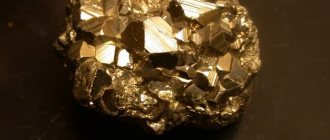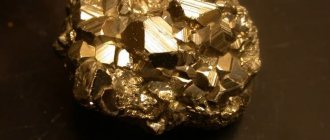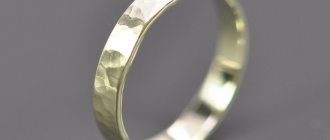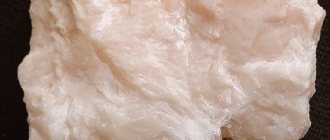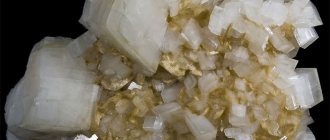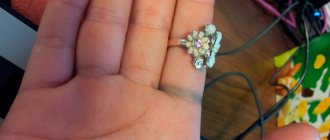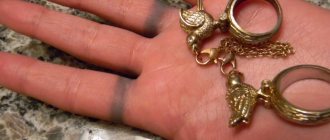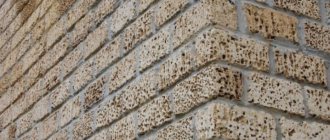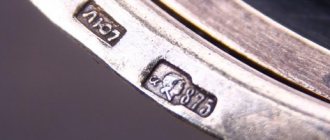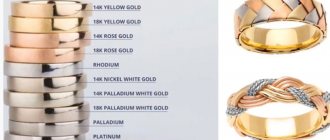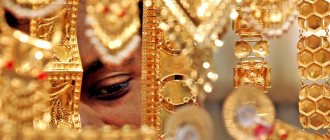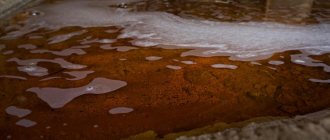Chalcopyrite is a mineral that is found on almost every continent in copper ore deposits and hydrothermal veins. The stone is formed through a metamorphic process and has the form of a granular mass. Translated from Greek, the name of the mineral consists of two words “chalcos” - copper and “pyrites” - pyrite. Another common name is also copper pyrite. The term "chalcopyrit" was coined in 1725 by the German chemist Henckel. The stone is in demand in mechanical engineering, construction, industry and has magical properties.
Chalcopyrite is also called “golden blende” and “false gold”
History and origin
Chalcopyrite is one of the oldest minerals. Even before our era, it was found in the mining of tin and copper.
Shiny stones were often mistaken for gold (as was pyrite, which is similar in composition). Charlatans slipped it to gullible people under the guise of metal number one.
This effect was created by inclusions of gold, silver, and other metals contained in chalcopyrite.
It is not surprising that several names have been assigned to the mineral, and the most famous are fool's gold, false gold, donkey gold, and gold blende .
Chalcopyrite is the official mineralogical name of the mineral. At the everyday level, the term “copper pyrite” is used. It appeared three hundred years ago as a partial translation from ancient Greek: “chalcos” means “copper”.
The chemical formula plus the composition, in which copper and sulfur are almost equal, give grounds to classify chalcopyrite as copper-sulfur pyrite.
Copper production by electrolysis
Electrolysis of copper is one of the stages of chemical-physical processes to which ore is subjected to obtain copper. It is noteworthy that to obtain 1 ton of pure copper, you will need to process at least 200 tons of copper ore. The copper ore processing procedure itself is a multi-stage and very complex process that consists of 7 stages. The latest is copper electrolysis. After mining, the ore must be crushed in special machines. Next, the flotation process occurs, as a result of which, as we know, a concentrate is formed while preserving copper minerals. After this, firing occurs at high temperatures in special furnaces. The charge obtained during the firing process is placed in a smelting furnace, where it becomes matte, which in turn is sent for conversion. The product obtained after these processes is called blister copper, where 2-3% of the volume is occupied by impurities. The impurities include zinc, iron, or sulfur. They are removed by an oxidation reaction. At this stage, “red” copper is formed, which contains 99.7-99.9% Cu. The last stage is the electrolysis of copper itself, which allows us to obtain the purest copper possible. To carry out the copper electrolysis process, you will need special equipment, namely containers that are filled with an aqueous solution of copper sulfate containing free sulfuric acid. As a result of electrolysis, we will obtain a deposit of pure copper on the cathodes. And everything that ends up at the bottom of the bath is usually called sludge. It is a raw material for the production of precious metals.
Physico-chemical characteristics
Chalcopyrite is one of the oldest copper-containing formations, an opaque ferrous-copper agglomerate. Belongs to the group of pyrites.
Main properties and characteristics:
- formula of copper pyrite – CuFeS2;
- chalcopyrite class – sulfides;
- origin – hydrothermal;
- aggregates – granular;
- syngony - tetrahedrons;
- cleavage – imperfect;
- density – 4.10-4.31 g/cm3;
- fracture – conchoidal to uneven
- hardness on the Mohs scale – 3.5-4;
- shine – metallic;
- specific gravity – 4.30;
- melting point – 1000°C;
- electrical conductivity – high;
- interaction with acids - soluble in sulfuric acid (pure sulfur precipitates), resistant to hydrochloric acid.
The color and shades are yellowish-golden, the mineral imitates red gold. There are blue, variegated, greenish, yellow specimens. They are created by inclusions-veins of silver, gold, and other components. For example, coal makes the mineral almost black. When burned, such samples become a magnetic core.
The surface of the crystals and along the chips are characterized by a brightly variegated tarnish.
If chalcopyrite is constantly exposed to air, after a few hundred years it will become malachite.
The mineral is easily scratched by sharp objects.
Preparation of copper oxide
Copper (II) oxide CuO is a black crystal that undergoes crystallization in a monoclinic system. The density of the compound is 6.51 g/cm3, and it melts at a temperature of 1447 ° C under high pressure conditions. As a result of heating to 1100°C, copper (I) oxide is released:
Copper oxide does not dissolve in water and does not react with it. It has weak amphoteric properties with a predominance of basic ones. Reacts with aqueous solutions of ammonia to form tetraammine copper (II) hydroxide:
It also easily reacts with dilute acids, releasing salt and water:
The result of the fusion of copper oxide with alkalis is the formation of cuprates:
Pure copper oxide can be obtained by reduction with hydrogen, carbon monoxide and active metals:
The reaction for producing copper oxide by calcination of copper (II) hydroxide at a temperature of 200°C:
Copper oxide can also be obtained through the oxidation of copper metal in air at a temperature of 400–500°C:
Place of Birth
Chalcopyrite has been found on almost all continents. But not independently, but in other rocks. It is impossible to find pure chalcopyrite, only intergrown with chrysolite or quartz druses.
Copper pyrite
The ore from each deposit differs in properties and quality:
- Russia. In the Urals and Kola Peninsula, minerals of a greenish tint are mined. The agglomerates are large, up to half a meter. Mining in the vicinity of Norilsk is unprofitable: the raw materials are heavily “contaminated” with impurities.
- Japan. Honshu Island. Small crystals of chalcopyrite grow together in the form of pyramids.
- France. A jewelry grade mineral, the most expensive one resembles gold.
- Kazakhstan. Mining in the Dzhezkazgan region, agglomerates are small.
- Mexico. Zacatecas area, small stones.
- South America. The aggregates form intergrowths with sphalerite. Sometimes they have to be separated.
Industrial scale deposits of chalcopyrite are concentrated in mines rich in polymetallic raw materials.
Preparation of copper sulfide
Copper(II) sulfide or copper monosulfide - CuS, is an inorganic binary compound of divalent copper with sulfur. It is of the correct color, does not dissolve in water, and is also acidic in dilute solutions. In nature, it can be found in the form of the rare mineral covellite. Copper sulfide is obtained through direct interaction of elements, as well as as a result of the exchange reaction of divalent copper salts with water-soluble sulfides.
- Na2S+CuSO4=CuS+Na2SO4
- CuCl2 + H2S —> CuS + 2HCl
- 2CuS + H2 —>Cu2S + H2S. This reaction occurs under high temperature conditions of 600 to 700 oC
Preparation by the dry method gives copper sulfide the ability to conduct electric current. When the thermometer reaches 400 °C, noticeable decomposition of sulfide is observed.
Source
Where is the mineral used?
The areas of application of copper pyrite are industry and beauty. Each takes its own raw materials:
- Industry. Here, chalcopyrite is the source for the production of copper and the enrichment of ores (for example, copper-zinc). There is only a third of copper in chalcopyrite nuggets, but the availability of mining, shallow occurrence, plus an abundance of deposits make the process profitable.
- Collection material . Collectors value chalcopyrite with tarnish and specimens with textured ribbed edges. Variegated, multi-colored fragments with rock protrusions on the surface are valued. The cost starts from 400–500 rubles per sample.
- Jewelry making. The stone is classified as ornamental. Jewelry with it is often created by single craftsmen. Jewelry companies do not use sulfide due to the low cost of materials (and therefore the final product) and problematic processing. Chalcopyrite is fragile, brittle, and tends to oxidize in air, becoming covered with an unaesthetic film.
Craftsmen make pendants, earrings, and rings. The most precious frame of the products is 925° silver. More often it is a jewelry alloy, brass, bronze, cupronickel. Prices do not go beyond a couple of thousand rubles.
Jewelry with chalcopyrite
The object of dreams for craftsmen and consumers is chalcopyrite from France. It has a special meaning because it looks like gold thanks to its rich golden tone and soft glow.
Stone cost
Earrings and ring made of chalcopyrite stone
Chalcopyrite is an inexpensive mineral that is used primarily for making jewelry. Its final price depends on the size, setting and number of stones in the product. For example:
- from $50 for earrings in a silver frame;
- A pendant costs $15-20;
- A silver ring with chalcopyrite costs $50-80.
The cost of collectible stones starts from $10. The price of individual samples at auction can reach several thousand dollars.
How to spot a fake
Chalcopyrite is a popular imitation of gold. But they are also trying to falsify it. Under the guise of a mineral, they offer plastic or coated glass.
It is easy to distinguish one from the other:
- Scratch the sample. Even a fingernail can easily damage the coating on the imitation.
- Pass the sample over a hard surface. Chalcopyrite will leave a greenish-black mark.
- Look into the light. The natural mineral is opaque and impenetrable to light.
The mineral does not lend itself to elegant processing: mostly it is cabochons, beads or simple geometric shapes. Unlike plastic, chalcopyrite jewelry is rough. They look interesting though.
You can distinguish pyrite and chalcopyrite by color: the latter has a more intense yellow.
Preparation of copper chloride
In nature, copper chloride is found in the very rare mineral ernochalcite CuCl₂•2H₂O, which is blue crystals. Divalent copper chloride has important practical significance, and its extraction from natural minerals alone is very limited. Therefore, scientists have come up with several ways to artificially obtain this compound. The main reaction of the industrial synthesis of CuCl₂ can be called the chlorination reaction of copper sulfide under high temperature conditions from 300 to 400 degrees °C. The reaction looks like this
Another option for the synthesis of cuprous chloride is chlorinating roasting, which is carried out at temperatures above 500 C:
- CuS + 2NaCl + 2O₂ ―› CuCl₂ + Na₂SO₄
Both reactions require the use of specialized equipment and increased safety precautions; for this reason, these reactions can only be carried out under industrial production conditions. In laboratory conditions, you can also obtain copper chloride by the following reactions
- Cu + Cl₂ ―› CuCl₂
- CuO + 2HCl ―› CuCl₂ +H₂O
- Cu(OH)₂ + 2HCl ―› CuCl₂ + 2H₂O. Neutralization reaction
- CuCO₃ + 2HCL ―› CuCl₂ + H₂O + CO₂. As a result of this reaction, the stronger acid will displace the acid residue of the weaker acid. A substitution reaction occurs
- 3Сu + 2HNO₃ + 6HCl ―› 3CuCl₂ + 2NO +4H₂0. This reaction is the most original. It occurs only in the presence of a mixture of two strong acids.
Magic properties
The magical properties of chalcopyrite have not been fully studied by the occult community. But there are some results.
Overall Impact
The following spheres of influence of the mineral have been identified:
- In Europe, chalcopyrite stone is a protective amulet for a home, apartment or office. To do this, place a large agglomerate on all window sills on the right side: so that they cannot be seen by strangers. The magic of the stone will create the necessary aura, put a shield against external “blackness”: envy, anger, witchcraft.
- Europeans are confident that meditation on chalcopyrite is a powerful tool for women. They acquire a gentle character, visual attractiveness, and look younger. Those who want to get married or find a boyfriend are fulfilled in this regard.
- Chalcopyrite is a mineral that protects business people, especially managers and those involved in trade.
- Helps creative people attract inspiration.
Only natural minerals have magical powers.
Jewelry with copper pyrite
Talismans
Chalcopyrite has a stronger effect through jewelry:
- Bracelet. Worn on the main hand, it guarantees the financial success of business enterprises and creative projects. Or will attract the opposite sex.
- Ring. It will awaken inspiration and attract the attention of the chosen person.
- Brooch. To protect against negativity (ill-wishers, envious people, the evil eye) it is worn closer to the heart.
Any decoration with chalcopyrite “prompts” the owner to make the right decision, warning against spontaneous actions or rash words.
Preparation of copper glycerate
A qualitative reaction to detect the presence of glycerol in solutions is carried out in the presence of copper (II) sulfate and sodium hydroxide solution. As a result of the reaction, copper glycerate is formed - a complex compound with a blue-cornflower blue hue. The chemical reaction is carried out as follows:
- a solution of sodium hydroxide is added to a solution of copper (II) sulfate, resulting in the solution turning blue. Thus, we observe the precipitation of copper (II) hydroxide
- after that, add a few ml of glycerin and mix the solution. The resulting precipitate dissolves to form an indigo-colored complex compound. This is copper glycerate.
Therapeutic effect
Lithotherapists have discovered the following properties and applications of the mineral:
- Antimicrobial, anti-inflammatory effect. It is created by a composition of pharmaceutical ointment and mineral crushed to powder. They lubricate the affected areas of the skin: eczema and dermatitis respond well to treatment.
- Emotional problems. Insomnia, anxiety in dreams and in reality, and depression are cured by chalcopyrite taken orally. A mixture is prepared from components ground to powder: mineral, chalk, sugar.
- Gastrointestinal tract. The mineral stimulates the production of gastric juice, and at the same time appetite.
However, those wishing to use this remedy, especially internally, should be careful. Iron, sulfur, copper can cause problems - for example, increased bile production. If you feel unfavorable diagnostic signs, stop taking the drug. If necessary, consult a doctor.
Chalcopyrite and the Zodiac
According to the horoscope, the mineral is suitable for anyone and will have a good effect on representatives of all zodiac signs:
- It helps Aries to organize their personal lives and create a family home.
- Taurus will be assisted with business contacts, profitable contracts, and acquiring housing.
- Gemini will overcome physical allergies and find good friends.
- Cancers will improve health: pathogenic microflora in the gastrointestinal tract and internal inflammation are neutralized.
- Charismatic, ambitious Leos will become even more confident in themselves and decide to implement megaprojects.
- Pedantic Virgos will find gentleness, which will have a beneficial effect on their home environment and inner sense of self.
- Suitable for Libra as a barrier against infectious diseases and suspiciousness.
- Scorpios will strengthen their authority at home and at work.
- Sagittarius will sleep more soundly and make fewer mistakes when making decisions.
- For Capricorns, the talisman will become an assistant in difficult situations.
- Aquarians will see familiar things in a new light and will soberly evaluate temptations.
- Pisces need artifacts with minerals to maintain physical condition.
Compatibility table of copper pyrite with zodiac signs (“+++” – fits perfectly, “+” – can be worn, “-” – is strictly contraindicated).
| Zodiac sign | Compatibility |
| Aries | + |
| Taurus | + |
| Twins | + |
| Cancer | + |
| a lion | + |
| Virgo | + |
| Scales | + |
| Scorpion | + |
| Sagittarius | + |
| Capricorn | + |
| Aquarius | + |
| Fish | + |
The general effect of the mineral for all zodiac signs is assistance in the business or professional sphere.
However, if discomfort is felt with constant wearing, contact with the mineral should be limited, and the mineral should be used only in difficult cases.
Stone care
Chalcopyrite ring
Since chalcopyrite is characterized by extremely high fragility and the property of rapid oxidation upon contact with air, constant and careful care is necessary for it:
- store the gem in a separate soft case;
- remove the oxide film immediately after it appears, to do this, carefully wipe the stone with a soft, dry cloth;
- to prevent oxidation, it is recommended to store collection stones in a tightly closed glass container;
- Jewelry with stones should be removed when performing household tasks, physical activity, or while taking water procedures.
